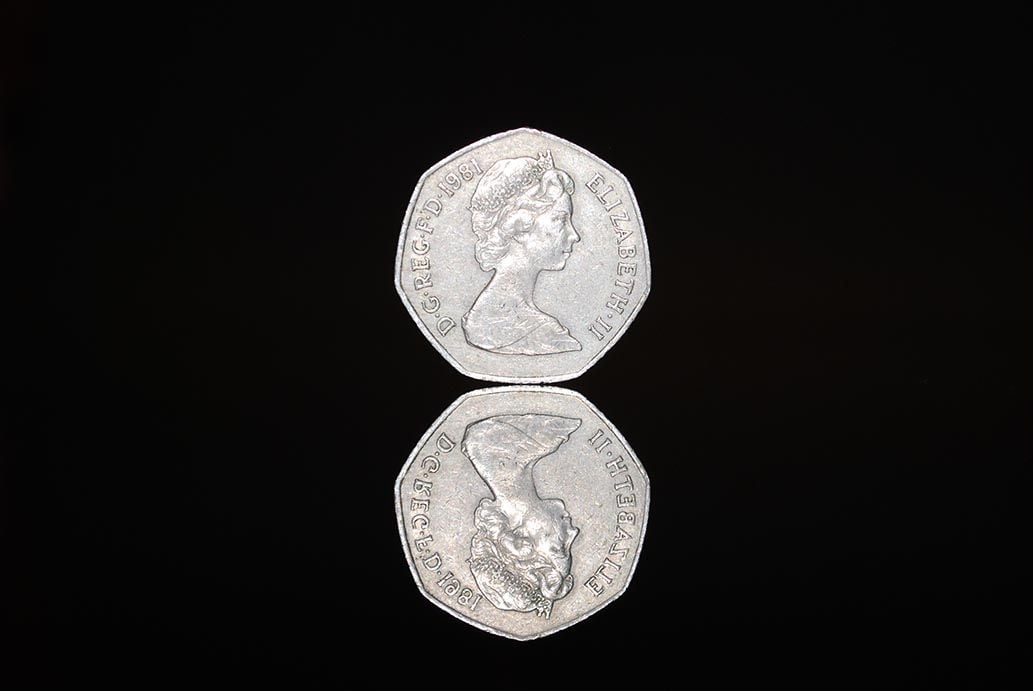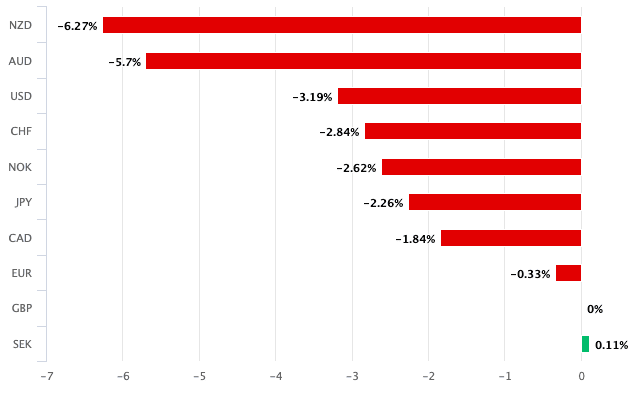The Laggard: Pound Sterling Struggling against Euro, Dollar and all G10 Rivals
- Written by: Gary Howes
-
- GBP screens as near-worst performer of past month
- Backdrop suggests more of the same likely
- UK economy stronger than expected in Jan

Image © Adobe Images
The British Pound looks vulnerable to further losses against the Dollar, an unsurprising finding given recent trends, but also against the Euro which is now looking less vulnerable to the war in Ukraine.
The Pound has fallen against most major currencies over the past week, with a 1.60% decline being registered against the Euro and a 0.86% fall coming against the Dollar.
In fact, when screened over a one-month horizon the Pound is at risk of being the worst performing major currency, contending for the 'wooden spoon' with Sweden's Krona.
In short, the Pound finds itself in an unsupportive global environment characterised by war in Ukraine, rising inflation and expectations for falling global growth.
The prospect of a Bank of England interest rate rise next week is of scant support to Sterling bulls.
Therefore, for now at least, the path of least resistance for Pound exchange rates in the near-term looks to be lower.

Above: GBP is about to screen as the worst performing major currency of the past week.
- Reference rates at article's last update:
GBP/EUR: 1.1904 \ GBP/USD: 1.3077 - High street bank rates (indicative): 1.1671 \ 1.2811
- Payment specialist rates (indicative): 1.1844 \ 1.3012
- Find out more about specialist rates and service, here
- Set up an exchange rate alert, here
Given the war in Ukraine is unlikely to end soon and external inflationary pressures continue to mount, the Pound's trend of weakness associated with the war is likely to persist.
Interestingly, the Euro was at one stage one of the more prominent losers of the war with GBP/EUR surging to post-Brexit highs above 1.21 as recently as Monday, but this is no longer the case.
Ulrich Leuchtmann, Head of FX and Commodity Research at Commerzbank, says the Euro might have fully priced in the negative effects of the war.
"The FX market is getting used to the war," says Leuchtmann in a currency briefing note out on March 11. "I do not mean that in a cynical way. It means that at lows close to 1.08 the market seems to have fully priced in the new situation, that the process of looking for a new market balance had been completed at these levels".
The Pound traditionally tends to underperform in times of global market anxiety: indeed, the Pound to Euro exchange rate's lowest points came not in the wake of the Brexit referendum in 2016 but rather following the financial crash of 2008 and the outbreak of Coronavirus fears in early 2020.
Therefore should the global equity market be in for a protracted drawdown it is hard to see the Pound perform strongly.
Above: Long-term chart showing periods of maximum GBP/EUR weakness.
Secure a retail exchange rate that is between 3-5% stronger than offered by leading banks, learn more.
Hopes for peace in Ukraine could offer some relief to markets and ease downside pressures on Sterling, but the abject failure of talks between Russian and Ukrainian foreign ministers on Thursday suggests there is little scope for a breakthrough near-term.
"The fact that the negotiations failed should make it very clear to any FX trader that the war will not come to an end that easily," says Leuchtmann.
Pound Sterling is looking particularly vulnerable to the Dollar with the Pound to Dollar exchange rate now at its lowest levels since November 2020 at 1.3080.
The Dollar remains a preferred haven amidst geopolitical tensions and broadening expectations for a global economic slump, linked to the surging cost of commodities.
Furthermore, expectations for a rapid series of Federal Reserve interest rate hikes, starting in March, are adding to the Greenback's bid.
Domestically though, the news could be worse.
Data out on Friday show the UK economy entered the Ukrainian crisis on a strong footing with GDP data for January beating expectations.
GDP rose 0.8% month-on-month in January according to the ONS, up on December's -0.2% and ahead of market expectations for 0.2%.
Year-on-year growth read at 10.0%, better than the 9.3% the market was looking for and stronger than the 6.0% figure released in December.
The ONS reports all sectors grew in January 2022, with services up 0.8%, production up 0.7% and construction up by 1.1%.
The stronger-than-expected data is supportive of the view that the Bank of England will raise rates again in March, and perhaps again over coming months.
Theoretically this is supportive of Sterling, but the market appears to have fully priced in the prospect of higher interest rates.
Therefore this channel may no longer be the source of support to the UK currency that it was at the start of the year.











